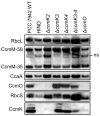Structural determinants of the outer shell of β-carboxysomes in Synechococcus elongatus PCC 7942: roles for CcmK2, K3-K4, CcmO, and CcmL
- PMID: 22928045
- PMCID: PMC3425506
- DOI: 10.1371/journal.pone.0043871
Structural determinants of the outer shell of β-carboxysomes in Synechococcus elongatus PCC 7942: roles for CcmK2, K3-K4, CcmO, and CcmL
Abstract
Cyanobacterial CO(2)-fixation is supported by a CO(2)-concentrating mechanism which improves photosynthesis by saturating the primary carboxylating enzyme, ribulose 1, 5-bisphosphate carboxylase/oxygenase (RuBisCO), with its preferred substrate CO(2). The site of CO(2)-concentration is a protein bound micro-compartment called the carboxysome which contains most, if not all, of the cellular RuBisCO. The shell of β-type carboxysomes is thought to be composed of two functional layers, with the inner layer involved in RuBisCO scaffolding and bicarbonate dehydration, and the outer layer in selective permeability to dissolved solutes. Here, four genes (ccmK2-4, ccmO), whose products were predicted to function in the outer shell layer of β-carboxysomes from Synechococcus elongatus PCC 7942, were investigated by analysis of defined genetic mutants. Deletion of the ccmK2 and ccmO genes resulted in severe high-CO(2)-requiring mutants with aberrant carboxysomes, whilst deletion of ccmK3 or ccmK4 resulted in cells with wild-type physiology and normal ultrastructure. However, a tandem deletion of ccmK3-4 resulted in cells with wild-type carboxysome structure, but physiologically deficient at low CO(2) conditions. These results revealed the minimum structural determinants of the outer shell of β-carboxysomes from this strain: CcmK2, CcmO and CcmL. An accessory set of proteins was required to refine the function of the pre-existing shell: CcmK3 and CcmK4. These data suggested a model for the facet structure of β-carboxysomes with CcmL forming the vertices, CcmK2 forming the bulk facet, and CcmO, a "zipper protein," interfacing the edges of carboxysome facets.
Conflict of interest statement
Figures





Similar articles
-
β-Carboxysomal proteins assemble into highly organized structures in Nicotiana chloroplasts.Plant J. 2014 Jul;79(1):1-12. doi: 10.1111/tpj.12536. Epub 2014 Jun 9. Plant J. 2014. PMID: 24810513 Free PMC article.
-
Heterohexamers Formed by CcmK3 and CcmK4 Increase the Complexity of Beta Carboxysome Shells.Plant Physiol. 2019 Jan;179(1):156-167. doi: 10.1104/pp.18.01190. Epub 2018 Nov 2. Plant Physiol. 2019. PMID: 30389783 Free PMC article.
-
Carboxysome Mispositioning Alters Growth, Morphology, and Rubisco Level of the Cyanobacterium Synechococcus elongatus PCC 7942.mBio. 2021 Aug 31;12(4):e0269620. doi: 10.1128/mBio.02696-20. Epub 2021 Aug 3. mBio. 2021. PMID: 34340540 Free PMC article.
-
Comparative analysis of carboxysome shell proteins.Photosynth Res. 2011 Sep;109(1-3):21-32. doi: 10.1007/s11120-011-9624-6. Epub 2011 Jan 30. Photosynth Res. 2011. PMID: 21279737 Free PMC article. Review.
-
Advances in the bacterial organelles for CO2 fixation.Trends Microbiol. 2022 Jun;30(6):567-580. doi: 10.1016/j.tim.2021.10.004. Epub 2021 Nov 19. Trends Microbiol. 2022. PMID: 34802870 Review.
Cited by
-
Diurnal Regulation of In Vivo Localization and CO2-Fixing Activity of Carboxysomes in Synechococcus elongatus PCC 7942.Life (Basel). 2020 Aug 29;10(9):169. doi: 10.3390/life10090169. Life (Basel). 2020. PMID: 32872408 Free PMC article.
-
Comparative Genomic Analysis Revealed Distinct Molecular Components and Organization of CO2-Concentrating Mechanism in Thermophilic Cyanobacteria.Front Microbiol. 2022 May 6;13:876272. doi: 10.3389/fmicb.2022.876272. eCollection 2022. Front Microbiol. 2022. PMID: 35602029 Free PMC article.
-
Prospects for Engineering Biophysical CO2 Concentrating Mechanisms into Land Plants to Enhance Yields.Annu Rev Plant Biol. 2020 Apr 29;71:461-485. doi: 10.1146/annurev-arplant-081519-040100. Epub 2020 Mar 9. Annu Rev Plant Biol. 2020. PMID: 32151155 Free PMC article. Review.
-
β-Carboxysomal proteins assemble into highly organized structures in Nicotiana chloroplasts.Plant J. 2014 Jul;79(1):1-12. doi: 10.1111/tpj.12536. Epub 2014 Jun 9. Plant J. 2014. PMID: 24810513 Free PMC article.
-
Direct characterization of the native structure and mechanics of cyanobacterial carboxysomes.Nanoscale. 2017 Aug 3;9(30):10662-10673. doi: 10.1039/c7nr02524f. Nanoscale. 2017. PMID: 28616951 Free PMC article.
References
-
- Price GD (2011) Inorganic carbon transporters of the cyanobacterial CO2 concentrating mechanism. Photosynth Res 109: 47–57. - PubMed
-
- Price GD, Badger MR, Woodger FJ, Long BM (2008) Advances in understanding the cyanobacterial CO2-concentrating-mechanism (CCM): functional components, Ci transporters, diversity, genetic regulation and prospects for engineering into plants. J Exp Bot 59: 1441–1461. - PubMed
-
- Espie GS, Kimber MS (2011) Carboxysomes: cyanobacterial RubisCO comes in small packages. Photosynth Res 109: 7–20. - PubMed
-
- Badger MR, Hanson D, Price GD (2002) Evolution and diversity of CO2 concentrating mechanisms in cyanobacteria. Funct Plant Biol 29: 161–173. - PubMed
-
- Badger MR, Price GD (2003) CO2 concentrating mechanisms in cyanobacteria: molecular components, their diversity and evolution. J Exp Bot 54: 609–622. - PubMed
Publication types
MeSH terms
Substances
LinkOut - more resources
Full Text Sources
Other Literature Sources
Molecular Biology Databases

